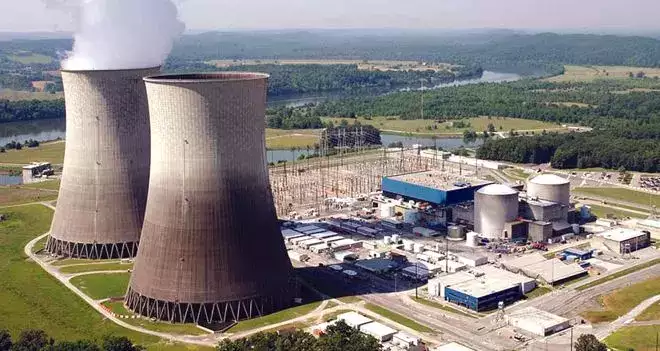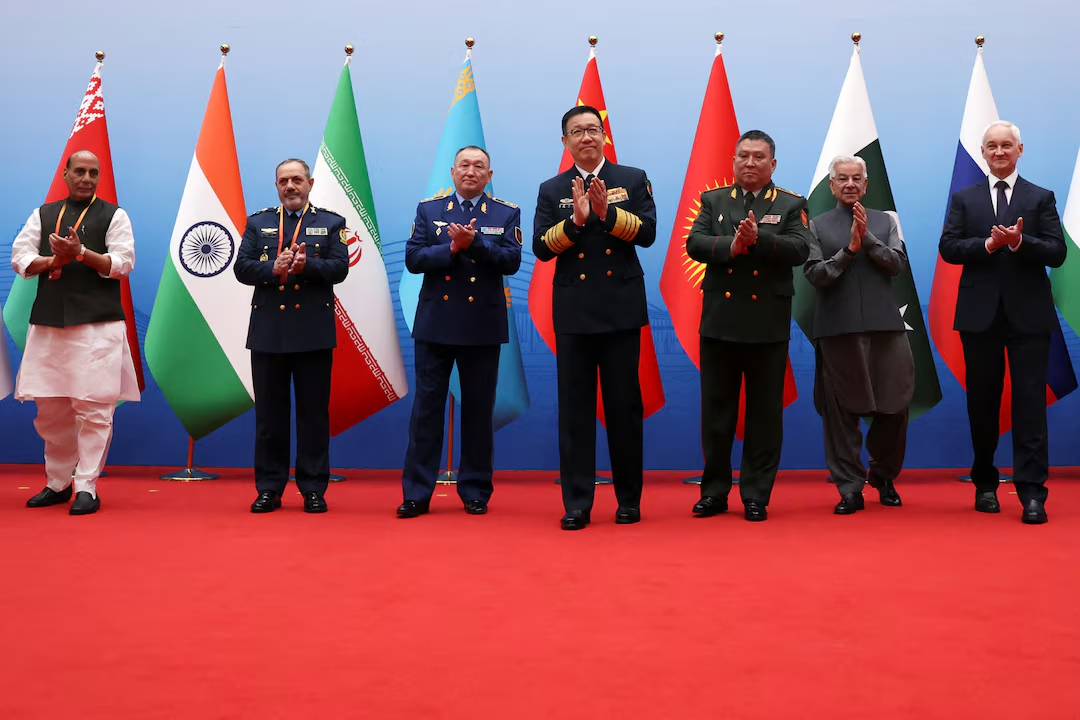- Courses
- GS Full Course 1 Year
- GS Full Course 2 Year
- GS Full Course 3 Year
- GS Full Course Till Selection
- Answer Alpha: Mains 2025 Mentorship
- MEP (Mains Enrichment Programme) Data, Facts
- Essay Target – 150+ Marks
- Online Program
- GS Recorded Course
- Polity
- Geography
- Economy
- Ancient, Medieval and Art & Culture AMAC
- Modern India, Post Independence & World History
- Environment
- Governance
- Science & Technology
- International Relations and Internal Security
- Disaster Management
- Ethics
- NCERT Current Affairs
- Indian Society and Social Issue
- NCERT- Science and Technology
- NCERT - Geography
- NCERT - Ancient History
- NCERT- World History
- NCERT Modern History
- CSAT
- 5 LAYERED ARJUNA Mentorship
- Public Administration Optional
- ABOUT US
- OUR TOPPERS
- TEST SERIES
- FREE STUDY MATERIAL
- VIDEOS
- CONTACT US
Gorakhpur to Host North India’s First Nuclear Plant
Gorakhpur to Host North India’s First Nuclear Plant

Introduction
- India has announced its first nuclear power plant in North India, to be built in Gorakhpur, Haryana, Union Minister Dr. Jitendra Singh confirmed in the Lok Sabha. This marks a step forward in India’s clean energy plans as it targets net-zero emissions by 2070.
- At the same time, the government is pushing ahead with the long-delayed Jaitapur Nuclear Power Project in Maharashtra, addressing environmental and safety concerns while finalizing technical and commercial agreements.
India’s Nuclear Energy Vision & Targets
Nuclear energy is central to India’s clean energy strategy. It provides a stable, low-carbon alternative to fossil fuels and supports long-term energy security.
- At the COP26 summit in Glasgow (2021), India committed to achieving net-zero carbon emissions by 2070. Nuclear power is expected to play a major role in this transition.
- The government aims to increase nuclear power capacity from 8,180 MW to 22,480 MW by 2031-32 and reach 100 GW by 2047
- Nuclear energy has several advantages:
- It produces zero greenhouse gas emissions during operation.
- Offers consistent base-load power, unlike solar or wind.
- Reduces dependence on imported fossil fuels.
- Has a long operational lifespan, often up to 60 years.
Gorakhpur Nuclear Power Project
- The Gorakhpur Nuclear Power Project (GNPP) is set to become North India’s first nuclear power plant, marking a geographic shift in India’s nuclear infrastructure.
- Located in Fatehabad district, Haryana, the project is seen as a key milestone in India’s plan to expand clean energy access across all regions.
- The project will include two pressurised heavy water reactors (PHWRs), each with a capacity of 700 megawatts (MW).
- The reactors are being developed by the Nuclear Power Corporation of India Limited (NPCIL) using indigenous technology.
- Construction began in 2018, but the project has seen delays due to land acquisition, regulatory clearances, and funding issues.
- Once operational, the plant will add 1,400 MW of clean electricity to the national grid.
- Gorakhpur is strategically important for several reasons:
- It brings nuclear energy to North India, which has so far relied mostly on coal and hydroelectricity.
- It supports regional development through job creation and infrastructure.
- It aligns with India’s vision of balanced energy access across all states.
Jaitapur Nuclear Power Project
- The Jaitapur Nuclear Power Project in Maharashtra is expected to become the largest nuclear power plant in the world once completed, with a total planned capacity of 10,380 megawatts (MW).
- It will consist of six European Pressurised Reactors (EPRs), each generating 1,730 MW.
- The project was first proposed in 2008 through an agreement between India’s NPCIL and France’s EDF (Électricité de France).
- However, it has faced repeated delays due to changes in commercial terms, environmental concerns, and public opposition.
- The government maintains that comprehensive safety assessments and environmental impact studies have been conducted.
- Once operational, Jaitapur alone will contribute nearly 10% of India’s 2047 nuclear target, making it a central piece of the country’s clean energy strategy.
- Despite progress, the Jaitapur project remains controversial:
- It is located in Seismic Zone III, leading to fears about earthquake risks.
- Environmentalists have raised concerns about its impact on marine biodiversity and fisheries, especially given the coastal location.
- The original environmental clearance expired in December 2022, though Dr. Jitendra Singh clarified that this was due to procedural delays and not new objections. The renewal process is currently underway.
Environmental and Safety Issues Around Nuclear Projects
- While nuclear energy offers clean and consistent power, it also raises serious environmental and safety concerns, especially in a densely populated and ecologically diverse country like India.
- One of the key criticisms of nuclear projects—including Jaitapur and others—is their potential ecological impact. Environmentalists have warned about:
- Risks to marine ecosystems due to discharge of heated water,
- Threats to local biodiversity and fisheries-based livelihoods,
- Long-term waste disposal and its radioactive impact on land and water sources.
- Seismic vulnerability is another major issue. Projects like Jaitapur are located in Seismic Zone III, raising concerns about safety in the event of an earthquake. Activists cite the Fukushima disaster (Japan, 2011) as a reminder of nuclear risks in coastal and seismic-prone areas.
- The government has repeatedly stated that India’s nuclear plants are built with multi-layered safety systems and have passed rigorous impact assessments.
- According to the Atomic Energy Regulatory Board (AERB), Indian reactors follow international safety protocols for radiation protection, waste handling, and emergency preparedness.
- Another key aspect is the expiry and renewal of environmental clearances. For instance, the clearance for Jaitapur lapsed in December 2022, but was reportedly delayed due to procedural issues—not environmental objections. However, critics argue that renewed scrutiny is essential given evolving climate and seismic conditions.
- Nuclear waste management remains a long-term concern. Though Indian reactors generate relatively small volumes of high-level waste, there is no final deep geological repository yet operational in the country. Most spent fuel is stored at reactor sites under secure conditions.
Public Opposition and Local Protests Around Nuclear Projects
Public resistance has played a significant role in delaying several nuclear power projects in India, particularly in areas where local livelihoods, ecology, and land rights are at stake.
- Jaitapur: A Decade of Local Resistance
- Located in Ratnagiri district of Maharashtra, Jaitapur is a region known for its fishing economy and agricultural activities. Since the project’s announcement in 2008, thousands of local residents—particularly farmers and fishermen—have opposed the construction, citing:
- Displacement and land acquisition issues
- Located in Ratnagiri district of Maharashtra, Jaitapur is a region known for its fishing economy and agricultural activities. Since the project’s announcement in 2008, thousands of local residents—particularly farmers and fishermen—have opposed the construction, citing:
-
-
- Threats to marine life and fish stocks
- Fear of radiation leaks and accidents
- Massive protests erupted in 2011, where local demonstrations turned violent, leading to clashes with the police and even reported casualties.
- Over the years, opposition groups such as the Konkan Bachao Samiti and environmental NGOs have raised questions about transparency and the adequacy of impact assessments.
-
2. Other Nuclear Sites Facing Protests
Jaitapur is not an isolated case. Other projects have also seen opposition:
- Kudankulam (Tamil Nadu): Faced major protests in 2012 due to safety concerns post-Fukushima.
- Kovvada (Andhra Pradesh) and Mithi Virdi (Gujarat): Faced resistance over land acquisition and displacement.
- Chutka (Madhya Pradesh): Tribal communities have opposed the project due to fears of losing forest land.
While the government has maintained that all projects follow scientific safety norms and fair compensation laws, public trust has remained a challenge, especially in regions with weak local engagement or past displacement histories.
Efforts have been made to build awareness through public hearings, safety drills, and local consultations, but critics argue that these are often rushed or non-transparent.
India’s Operational and Upcoming Nuclear Power Plants
As per the Press Information Bureau India(NPCIL) currently operates 24 nuclear power reactors across 8 sites, with a total installed capacity of 8,180 MW.
Operational Nuclear Power Plants in India
|
S.No |
Plant Name |
State |
Capacity (MW) |
Units |
Type |
|
1 |
Tarapur 1 & 2 |
Maharashtra |
320 |
2 x 160 |
BWR |
|
2 |
Tarapur 3 & 4 |
Maharashtra |
1080 |
2 x 540 |
PHWR |
|
3 |
Kaiga 1–4 |
Karnataka |
880 |
4 x 220 |
PHWR |
|
4 |
Kakrapar 1, 2 & 3 |
Gujarat |
1140 |
2 x 220, 1 x 700 |
PHWR |
|
5 |
Kakrapar 4 |
Gujarat |
700 |
1 x 700 |
PHWR |
|
6 |
Rajasthan 1–6 |
Rajasthan |
1180 |
Mixed |
PHWR |
|
7 |
MAPS 1 & 2 |
Tamil Nadu |
440 |
2 x 220 |
PHWR |
|
8 |
Kudankulam 1 & 2 |
Tamil Nadu |
2000 |
2 x 1000 |
VVER |
|
9 |
Narora 1 & 2 |
Uttar Pradesh |
440 |
2 x 220 |
PHWR |
|
10 |
Rajasthan-7 |
Rajasthan |
630 |
1 x 630 |
PHWR |
Reactors Under Construction
|
Plant Name |
State |
Units |
Capacity (MW) |
Status |
|
Rajasthan 8 |
Rajasthan |
1 x 700 |
700 |
Under construction |
|
Gorakhpur 1 & 2 |
Haryana |
2 x 700 |
1400 |
Under construction |
|
Kudankulam 3–6 |
Tamil Nadu |
4 x 1000 |
4000 |
Under construction |
Planned Reactors
|
Plant Name |
State |
Units |
Capacity (MW) |
Status |
|
Jaitapur |
Maharashtra |
6 x 1650 |
9,900 |
In principle approval |
|
Kovvada |
Andhra Pradesh |
6 x 1100 |
6,600 |
In principle approval |
|
Haripur |
West Bengal |
6 x 1000 |
6,000 |
In principle approval |
|
Chutka |
Madhya Pradesh |
2 x 700 |
1,400 |
In principle approval |
|
Mahi Banswara |
Rajasthan |
4 x 700 |
2,800 |
In principle approval |
Future Targets
- 2025 Budget Initiatives: A new Nuclear Energy Mission aims to operationalize five Small Modular Reactors (SMRs) by 2033 and achieve 100 GW of nuclear power capacity by 2047.
- Capacity Expansion: Plans to increase nuclear capacity from 8,180 MW to 22,480 MW by 2031-32.
India’s Global Collaborations in Nuclear Energy
India’s civil nuclear program, once isolated due to non-signature of the Non-Proliferation Treaty (NPT), underwent a major transformation after the India–US Civil Nuclear Agreement (2008). Since then, India has built strategic collaborations with multiple countries to expand its nuclear capacity using advanced technologies and global financing.
1. France – Jaitapur Nuclear Power Project
- France’s Électricité de France (EDF) will supply six European Pressurised Reactors (EPRs) for the Jaitapur project in Maharashtra.
- Once completed, it will be the largest nuclear power station in the world at 9,900 MW.
2. Russia – Kudankulam Nuclear Power Plant (KKNPP)
- Russia’s Rosatom has partnered with NPCIL to construct six VVER-type reactors in Tamil Nadu.
- Units 1 & 2 (2,000 MW) are operational. Units 3 to 6 (4,000 MW) are under construction.
- Russia has provided technology, fuel, and expertise under an Indo-Russian framework signed in 1988 and renewed in 2008.
3. United States – Civil Nuclear Agreement & AP1000 Technology
- The India–US nuclear deal (2008) enabled India to access nuclear fuel and technology.
- The proposed Kovvada project in Andhra Pradesh is being discussed with US firms using AP1000 reactors developed by Westinghouse Electric Company.
- Final agreements are pending due to liability and commercial issues.
4. Japan – Civil Nuclear Cooperation Agreement (2017)
- The agreement allowed Japanese companies to supply equipment and components to India’s civil nuclear projects.
- Japan’s role is indirect but crucial due to its tech inputs and shareholding in reactor firms like Westinghouse and GE-Hitachi.
|
Bharat Small Reactors
|
Conclusion
India’s nuclear energy expansion, marked by the Gorakhpur and Jaitapur projects, is key to its clean energy and net-zero goals. While global collaborations and strong safety laws support this growth, public concerns around environment and safety remain. Balancing energy needs with ecological responsibility and local trust will be crucial as India scales its nuclear capacity in the decades ahead.
Nuclear Waste Management
|




